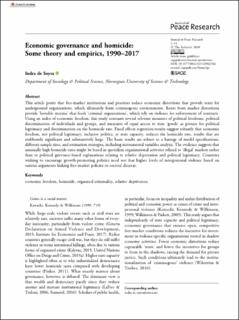| dc.contributor.author | de Soysa, Indra | |
| dc.date.accessioned | 2020-11-23T07:23:19Z | |
| dc.date.available | 2020-11-23T07:23:19Z | |
| dc.date.created | 2020-11-22T17:37:24Z | |
| dc.date.issued | 2020 | |
| dc.identifier.issn | 0022-3433 | |
| dc.identifier.uri | https://hdl.handle.net/11250/2688962 | |
| dc.description.abstract | This article posits that free-market institutions and practices reduce economic distortions that provide rents for underground organizations, which ultimately form criminogenic environments. Rents from market distortions provide ‘lootable income’ that feeds ‘criminal organizations’, which rely on violence for enforcement of contracts. Using an index of economic freedom, this study contrasts several relevant measures of political freedoms, political discrimination of individuals and groups, and measures of equal access to state ‘goods’ as proxies for political legitimacy and discrimination on the homicide rate. Fixed effects regression results suggest robustly that economic freedom, not political legitimacy, inclusive politics, or state capacity, reduces the homicide rate, results that are stubbornly significant and substantively large. The basic results are robust to a barrage of model specifications, different sample sizes, and estimation strategies, including instrumental variables analysis. The evidence suggests that unusually high homicide rates might be based in quotidian organizational activities related to ‘illegal’ markets rather than to political grievance-based explanations relating to relative deprivation and political legitimacy. Countries wishing to encourage growth-promoting policies need not fear higher levels of interpersonal violence based on various arguments linking free-market policies to societal disarray. | en_US |
| dc.language.iso | eng | en_US |
| dc.publisher | Sage Journals | en_US |
| dc.rights | Navngivelse 4.0 Internasjonal | * |
| dc.rights.uri | http://creativecommons.org/licenses/by/4.0/deed.no | * |
| dc.title | Economic Governance and Homicide: Some Theory and Empirics, 1990 – 2017 | en_US |
| dc.type | Peer reviewed | en_US |
| dc.type | Journal article | en_US |
| dc.description.version | acceptedVersion | en_US |
| dc.source.journal | Journal of Peace Research | en_US |
| dc.identifier.doi | https://doi.org/10.1177/0022343320962566 | |
| dc.identifier.cristin | 1850766 | |
| dc.description.localcode | https://creativecommons.org/licenses/by/4.0/This article is distributed under the terms of the Creative Commons Attribution 4.0 License (https://creativecommons.org/licenses/by/4.0/) which permits any use, reproduction and distribution of the work without further permission provided the original work is attributed as specified on the SAGE and Open Access pages (https://us.sagepub.com/en-us/nam/open-access-at-sage). | en_US |
| cristin.ispublished | true | |
| cristin.fulltext | postprint | |
| cristin.qualitycode | 2 | |

